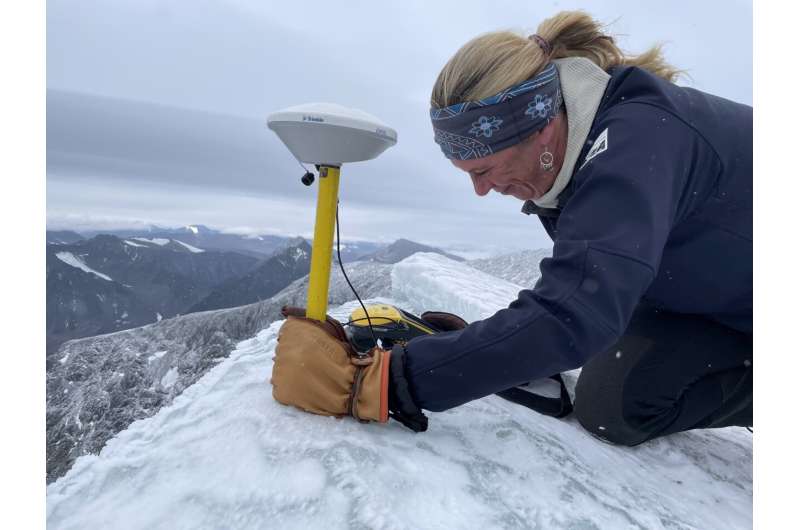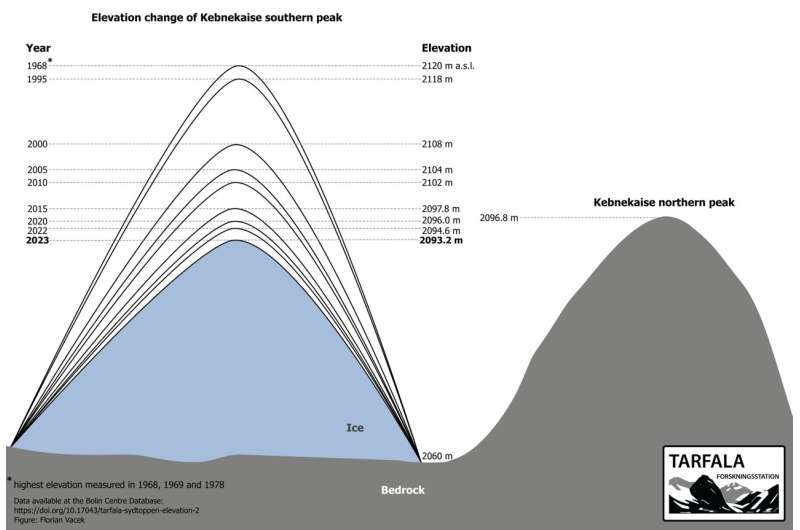This article has been reviewed according to Science X's editorial process and policies. Editors have highlighted the following attributes while ensuring the content's credibility:
fact-checked
trusted source
proofread
Kebnekaise's southern peak continues to melt, and so do other Swedish glaciers

The glacier on Kebnekaise's southern peak is shrinking. What was previously Sweden's highest summit is now 1.4 meters lower than last year. Measurements also show great melting on other Swedish glaciers.
On September 11, the annual measuring of Kebnekaise's southern peak was carried out. The height was measured at 2,093.2 meters above sea level. This is a decrease of 1.4 meters since September 2022, when the height was measured at 2,094.6 meters above sea level.
Since September 2019, Sweden has a new official highest point. Researchers at Stockholm University's research station in Tarfala then noted that Kebnekaise's southern peak was lower than the northern peak. The height of the southern peak, which is crowned by a glacier, was then 2,095.6 meters, compared to the northern peak's 2,096.8 meters. The northern peak consists of stone and has a height that does not change.
"The measurement of the southern peak was not easy this year due to strong winds on the summit, but we needed to take advantage of the only weather window that was available to be able to carry out the measurement before new snow is added to the southern peak as autumn is coming in the mountains," says Nina Kirchner, docent in glaciology and director of the Tarfala research station at Stockholm University.
Swedish glaciers are melting
Tarfala research station also participates in an international long-term monitoring program (World Glacier Monitoring Service) on mass balance calculations for reference glaciers. Of the approximately 50 reference glaciers in the world that are included, four are in Sweden.
These glaciers have been measured continuously for more than 30 years. The glaciers measured by the researchers at Stockholm University are Storglaciären (at the Tarfala research station), Rabot's glacier, Mårma and Riukojietna. All four glaciers have decreased compared to 2022. Rabot's glacier has decreased the most. Looking at average mass loss over the past 10 years, this year's loss has been twice the average for all four of these glaciers.

This year, the Rabot glacier and the Riukojeitna also melted in their highest areas. This means that the glaciers did not receive any new snow that could contribute to their growth. The snow that came in the winter melted away during the summer and even the ice that was no longer protected by the snow cover melted away.
"This could be the beginning of a glacier 'starving to death.' The glaciers now need a year of positive mass balance to compensate for the loss. If such a year does not occur, the loss is irreversible," says Nina Kirchner.
Kebnekaise and the Tarfala research station
The Kebnekaise massif has two peaks: a northern ice-free peak with exposed bedrock at a height of 2,096.8 meters above sea level and a southern ice-covered peak. Because of its ice cap, the south peak has a variable elevation—higher in winter due to snowfall and lower in summer due to snowmelt.
Recurring measurements of the height of the southern peak have been part of the measurement program at the nearby Tarfala research station since the late 1940s. The height is measured at the end of each summer, to capture the minimum height of the peak each year.
Until 2019, the south peak was higher than the north peak, but continued ice melting due to global warming has resulted in the south peak now being lower than the north peak. Over the last two decades, the height of the south peak has decreased by about 0.4 m per year (a total of 3.8 m between 2004 and 2013 and 4.3 m between 2014 and 2023). The remaining ice thickness at the southern summit is currently about 35 meters.
Provided by Stockholm University




















